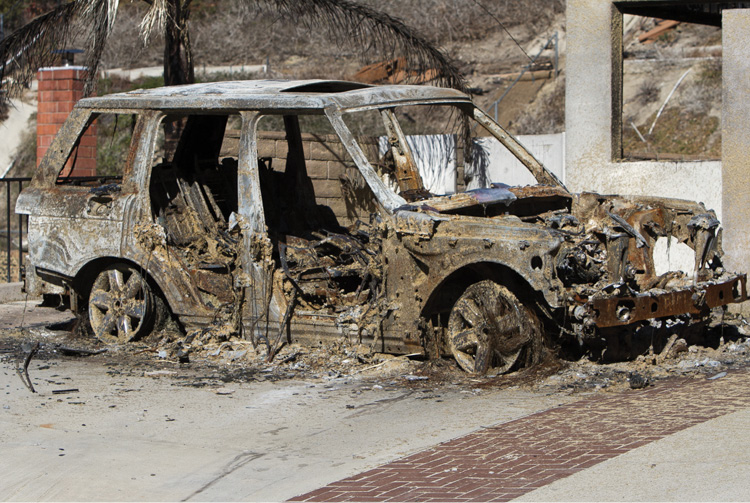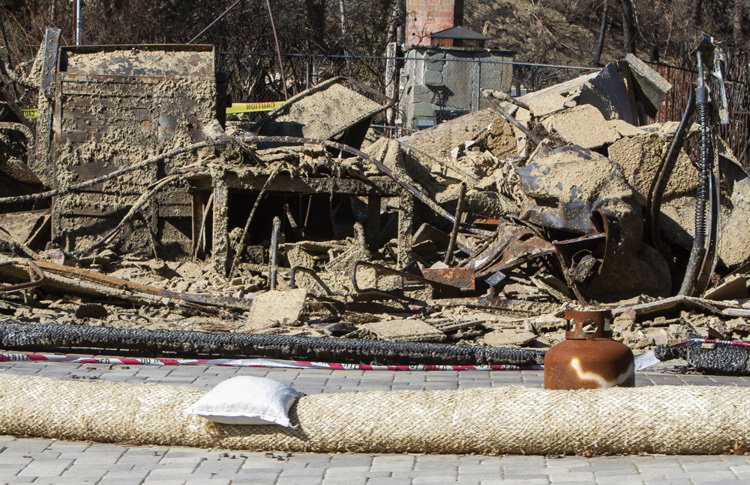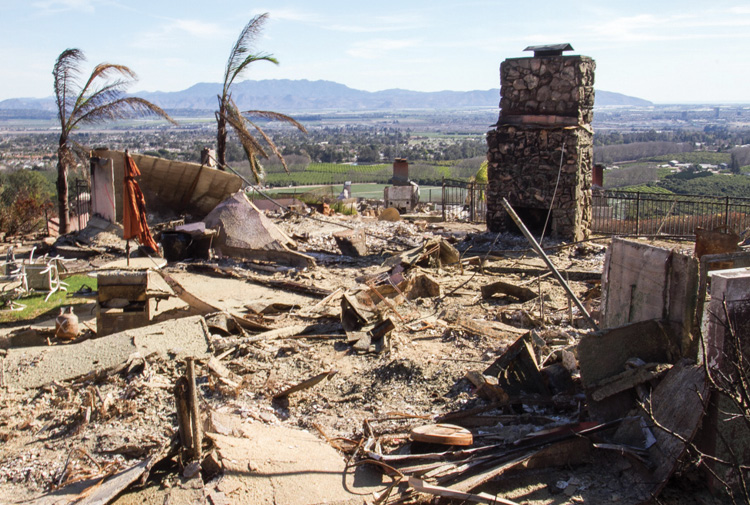
By DENA ALI
Nearly all forest ecosystems in the United States are “fire adapted” and require regular intervals of fire to remain healthy. Historically, fires occurred naturally from weather events such as lightning strikes. Cycles of fire helped prevent forests from becoming overgrown and infested with damaging insects as well as allowed the fires to burn out before becoming destructive without human intervention. However, land development has become problematic; it is one of the greatest threats to ecosystems in the United States. Years of poor urban planning and policymaking have led to a crisis for urban forests. Not only does human development destroy biodiversity, but it has also become the greatest contributor to destructive wildfires. This policy analysis explains methods for improving decades of poor policy and management decisions that have resulted in dangerous conditions among wildlands.

(1-5) Images of the aftermath of the Thomas Fire in Ventura County, California, on January 13, 2018. The fire started on December 4, 2017, and was fully contained on January 12, 2018. (Photos by Mike Legeros.)




Urban Planning Stats
Urban planners have the arduous task of ensuring that communities grow safely, residents have equal access to opportunity, and the environment is protected. The traditional approach to urban planning in the United States was problematic: It was unstructured, lacked flexibility, and allowed decision making by members with little training and knowledge to make vital decisions. These past inefficiencies have produced present-day problems that require resources for corrective action and inhibit opportunities for preventive actions.
Biodiversity and the environment are challenges to urban planning because of knowledge gaps in decision making and inadequate resources. Although urbanization is the leading cause of species imperilment in the United States, few government agencies have the available resources to employ a conservation planning specialist. However, there is an urgency to protect the environment because of rapid ecosystem deterioration in the face of urbanization. One of the fastest growing locations for urban development is the wildland urban interface (WUI), defined as the area where houses are in or near wildland vegetation. However, not only is this the area where wildfires pose the greatest risk to people because of their proximity to flammable vegetation, but people have also changed fire regimes. Making matters worse, nearly 84 percent of wildfires today are caused by humans, either through carelessness or arson.
The 2017 wildfire season was particularly disastrous and represents an upward trend of longer and more damaging wildfire seasons in North America. As reported by North Carolina Forest Service Public Information Officer Brian Haines, the National Interagency Fire Center reports that the number of homes lost to wildfire across the country more than doubled from 3,192 in 2016 to 8,057 in 2017. The Thomas Fire (photos 1-5) in southern California, which consumed 281,893 acres, was the largest wildfire recorded in the state’s history at that time. Its destruction was widespread and led to the loss of more than 1,000 buildings, the life of Cal-Fire Firefighter Cory Iverson, and devastating mudslides that killed 17 people. (At the time of this writing, California’s Camp Fire has now become the deadliest in the state’s history, with more than 75 casualties and nearly 13,000 structures destroyed.)
Over the past few decades, the amount of annual area burned as well as fire suppression costs have increased rapidly in the United States. From 1984-1994, the annual area that burned was 18,000 kilometers (km)2; this number nearly doubled for the years 2005-2014 to 33,000 km2. A recent University of Arizona (UA) study projects a continuation of these large fire seasons for years to come. According to the study, wildfires multiply when other forces like climate change lead to a cascade of ecological, hydrological, economic, and social consequences. The goal of the UA research was to provide quantitative data demonstrating a trend in hopes that the research will compel public agencies and legislatures to create more fact-based dialogue on sustaining forests and woodlands through smart management and policies.
Multiple complex, interrelated factors help drive longer, more destructive wildfire seasons in North America. These factors include expansion of urban development in and around forests, history of fire exclusion, and climatic factors such as drought. And, although the WUI occupies fewer than 10 percent of the land area in the United States, nearly half of all new houses built between 1990 and 2010 were built there. The convergence of human development in areas that are at risk for wildfire have led to a need for policy makers and urban planners to focus on sustainable solutions.
Today’s wildfire fire problem will not be solved by a singular approach but rather through collaboration from all those involved and responsible for the WUI. Such collaboration is necessary for those living in the WUI to learn how to coexist with fire. Public administrators and planners are challenged with understanding that there is not one top-down or bottom-up approach that will be effective without education, collaboration, and sincere effort from all responsible for and living in the WUI.
The Cost
Escaped wildfires are a destructive force that impacts lives, businesses, houses, national landmarks, and ecosystems. In recent years, the area of land burned by wildfire in the United States has increased dramatically. This increase is directly related to the expansion of private homes located in forested areas and the WUI. According to the United States Department of the Interior, federal firefighting costs reached $2.9 billion in 2017. Prior to 2017, these annual costs exceeded $2 billion just once (in 2015); this reflects an upward trend in the costs associated with mitigating wildfire risk. In 1990, federal firefighting costs were just under $400 million. In 2000, they reached $1.5 billion and, as stated, they reached $2 billion in 2015. Moreover, these costs do not account for the loss of life and homes or the damage done to our nation’s ecosystems.
When all costs associated with wildfire are accounted for, this number skyrockets. For example, officials in California predict that the total cost for the 2017 wildfire season will exceed $180 billion. These total costs include landscape rehabilitation; medical costs; insurance losses; cost to replace homes and businesses; economic productivity losses; and repair and replacement of key infrastructure such as roads, power lines, and dams.
We can attribute the abovementioned costs associated with wildfire to the continued urban expansion toward wildland areas. According to the United Nations, the world population is increasingly urban; if current trends continue, around 60 percent of the projected urban area in 2030 has yet to be built. In 2000, nearly one-third of U.S. homes were in the WUI; it has since become the area that has experienced the most rapid growth. Although there is a lack of census data and information about WUI growth in the past decade, most researchers agree that it remains one of the largest growing areas of urban development in the United States.
This WUI growth is not unique to the United States; European countries have faced similar expansion and wildfire destruction since World War II. The WUI has become popular for many reasons including its affordability, panoramic views, and ready access to natural settings and recreation.
The increasing number of homes in the WUI and associated costs of wildfire management have led to an urgent need for these communities to become fire adapted. Many people living in the WUI may not recognize that fire has historically played a fundamental ecological role in their community. Furthermore, it is now known that fire is necessary for the continued health of our nation’s ecosystems. Attempting to exclude fire to protect people living in the WUI paradoxically creates worsening fire conditions. However, the increased urbanism of wildlands makes fire management more complex for policy makers. They not only have to deal with human carelessness, but they are also faced with the need to protect more lives and properties.
Nevertheless, communities can reduce their risk of wildfire. According to the National Fire Protection Association (NFPA), reducing the loss of lives, property, infrastructure, and natural resources in the WUI depends on long-term community action. Communities can reduce their risk to damage by becoming knowledgeable about and engaged in actions to protect their homes and neighborhoods from wildfire; thus, they become fire adapted. With proper planning and implementation, fire-adapted communities can better prepare to safely coexist with wildfire as part of their surrounding landscapes.
Integrating Good Policy
There are numerous policy tools communities should consider when addressing environmental and wildfire problems. Because the WUI fire risk involves multiple actors, so, too, should the solutions. Individual homeowners can reduce their risk substantially by removing vegetation adjacent to their houses, using noncombustible roofing and building materials, and following the NFPA’s Firewise USA® recommendations. Communities can limit the impact of wildfire by coordinating fuel reduction efforts through prescribed burns and establishing wildfire management plans. Insurance companies can play a key role by reducing premiums for communities and homeowners who take mitigation action. Finally, jurisdictions can work to better plan for future land use and avoid housing expansion in high-risk wildfire areas.
When homes are built in and around forests, they become part of the WUI. A majority of the WUI is in fire-adapted forests; it is estimated that 94 percent of wildlands across the United States need fire to remain healthy and contribute to ecosystems. Forests play a major role in ecosystems, and one of their most important functions is absorbing the greenhouse gas carbon dioxide and releasing oxygen. Through this process, they provide a variety of ecosystem services to people such as air purification, global climate regulation, urban temperature regulation, and runoff mitigation. Additionally, healthy trees can absorb rainfall to prevent runoff, mudslides, and flooding.
According to the United States Forest Service (USFS), fire dependent ecosystems rely on fire to regenerate, minimize the spread of pests, prevent insect infection, recycle nutrients back into the soil, and sequester carbon to produce energy. Furthermore, periodic fire prevents fire-adapted forests from becoming overgrown and allows for restorative growth. Without fire, many forests would either rot or become overgrown, either of which will lead to an increased risk for a larger wildfire. Also, many planners don’t realize that insects are an integral part of the life cycle of many forests. However, in recent years, insect and disease outbreaks have increased across the country. Some of these outbreaks are linked to human activities that introduce and spread forest pests. These infestations lead to death of forests and a reduction of fuel moisture, which then leads to dead trees that are more flammable and prone to fire. For example, one in 14 trees in Colorado is dead, and Colorado forests have experienced a 30-percent increase in standing dead trees since 2010.
Fuel moisture is the amount of water in fuel—such as dead trees—and is an important factor affecting wildland fire behavior. Fuel moisture is the most important fuel characteristic that predicts fire occurrence, spread, and intensity. Basically, when there is reduced fuel moisture such as during insect infestation, fire is easier to start and spread. Today’s drying and drought trends are expected to continue in the southern United States and will increase the possibility of more frequent and intense wildfires.
For forests to remain healthy and limit insect infestations, they need regularly occurring fire. Records from more than 400 years of fire-adapted tree ring data demonstrated that healthy forests have experienced fires at intervals ranging from two to 25 years, depending on the species. Moreover, until the past century, fire was an efficacious tool used by Native Americans and early European settlers to transform natural spaces by pushing back vegetation and providing space for different forms of land use. However, in August 1910, one of the largest wildfires in recorded history destroyed three million acres of land and killed 86 people in northern Idaho and Western Montana. “The Great Burn of 1910” has influenced poor forest fire policy and influences forest management to this very day.
Policies enacted in the wake of The Great Burn focused on quick suppression and fire exclusion across many wildlands. The Great Burn became a political turning point for federal involvement in wildfire suppression and changed public land management throughout the 20th century. In the early 20th century, the United States government had become the nation’s largest owner of forestland and had been given the authority to focus on aggressive fire suppression. However, researchers understand that fire cannot and should not be excluded from fire-adapted forests forever. Unintended consequences of fire exclusion have allowed “fuel” to build up and create more severe fire risk for forests and people in the WUI. USFS Department of Agriculture Chief Thomas Tidwell reports that overgrown forests and drought conditions are fueling today’s megafires. Sadly, it took decades to see how futile and misguided fire exclusion was and the tragic results it has led to, and it will take time to restore forests to their natural conditions.
According to the National Interagency Fire Center, in 2017, 66,131 wildfires burned an estimated 9,781,062 acres of land in the United States. Many scientists and natural resource managers report that these fires are increasing in size and intensity. They attribute these increases to a combination of drought conditions, movement of people into the WUI, and prior management decisions that led to fire suppression.
According to Tidwell, fire protection in the WUI is one of the thorniest issues faced by the USFS because it is bound up with complex challenges. Tidwell also states that a legacy of fire exclusion has caused forests to become overstocked and full of hazardous fuels. Moreover, these overstocked, drought-stressed forests are extremely susceptible to devastating outbreaks of insects and disease.
What’s more problematic is the growth and development into America’s wildlands. The number of houses within a half-mile of a national forest grew from 484,000 in 1940 to 1.8 million in 2000, while the number of houses within national forests grew from 335,000 in 1940 to 1.2 million in 2000. In 2010, it was predicted that from 2000 to 2030, housing density would grow onto 57 million acres of forestland across the country.
Complicating matters are the many suppression networks that become involved when a wildfire escapes containment lines and endangers forestland and communities. Escaped fire knows no boundaries and can span borders of individual landowners, local government, and federal land. Landowner coordination becomes critical for successful maintenance, prevention, and suppression. All of this has necessitated the creation of a coordinated and comprehensive strategy concerning wildfire mitigation.
References
DENA ALI is a captain with the Raleigh (NC) Fire Department. She previously served as a police officer for five years. Ali has a degree from North Carolina State University and an MPA from the University of North Carolina—Pembroke, where her research focused on firefighter suicide. She taught her class on suicide prevention at FDIC International 2018. Ali is a founding member of the Carolina Brotherhood.

